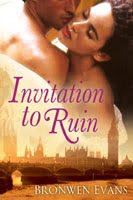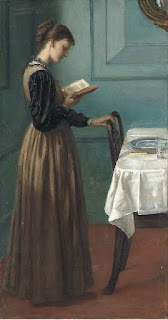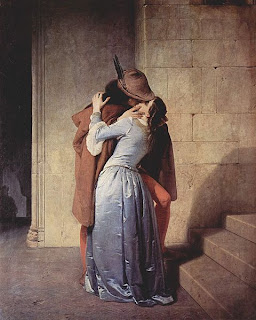Anthony James Craven, the Earl of Wickham, is dubbed Lord of Wicked for good reason. He lives and breathes seduction – until he mistakenly beds the wrong woman and is forced to marry the sensible, reserved Melissa Goodly. He intends to offer Melissa security and position, nothing more. Once they marry, Melissa cannot understand why her devastatingly attractive husband does not come to her bed. The more he pushes her away, the more she is resolved to turn the tables and open her shuttered heart to love. And though Anthony tries to resist the sensual siren that his wife has become, his plans for a companionable relationship are unravelling in the most pleasurable way…
 Today’s guest is Bronwen Evans who’s here to talk about her book INVITATION TO RUIN. Bronwen, congrats on your debut. Did you always intend INVITATION TO RUIN to be the first of a three book series, and what are the challenges of writing a series?
Today’s guest is Bronwen Evans who’s here to talk about her book INVITATION TO RUIN. Bronwen, congrats on your debut. Did you always intend INVITATION TO RUIN to be the first of a three book series, and what are the challenges of writing a series?
Thanks for having me over today. My INVITATION TO… series was always going to have at least four books, but I’ve had a few readers ask for Cassandra’s book – can I redeem her? That’s a challenge and I’m thinking about it. So maybe there will be five books. I’m only contracted for two, so we will have to wait and see how sales of book one go.
As a reader I love series romances, so it’s only natural that I wanted to write a series. Thankfully, I love plotting. Part of the fun of writing a series, for me, is plotting out the overarching story and then each individual book before I start writing them. I think that’s important because readers want to see all the characters continue on through the books, so you have to understand how they are going to interact and enrich the stories.
The challenge in writing a series is to have enough interesting and engaging secondary characters that make the reader want to read their story’s too. Stephanie Laurens (one of my favorite Regency authors) did this really well. The Cynster books are still my all-time favorite series. The secondary characters in each book were very compelling. They needed a book of their own.
Already I have fans wanting Rufus Knight, Viscount Strathmore, and Richard Craven, Anthony’s twin brother’s stories.
Tell us your “call” story.
It all seemed to happen fairly quickly. I finished INVITATION TO RUIN at the end of October 2009. It was my first completed manuscript. Although I had been trying to write for a few years, I had never finished a book before – loads of half completed books – would be writers, don’t do that – you can’t sell what isn’t finished! So I didn’t have any expectations for the book. I sent off a query letter to two editors who I thought might be interested in the book and three agents. I got a full request from all of them BUT in the mean time (there is a lesson here – don’t send out queries until the book is polished and ready) my critique partners suggested some changes (and they were right) to one chapter that meant re-writing the last five chapters.
So instead of sending the full, I sent the first three chapters, hoping nobody noticed. My reasoning was, why hurry the re-write if they weren’t interested. Blow me; four came back asking for the rest, one agent declined. It was now about 15th December 2009, and I was coming up for my Christmas break. I thought, I’ll finish the last remaining chapters in my break, and send in on 3rd January. However, Megan Records from Kensington rang me in New Zealand on the 20th December, chasing the rest of the book saying, “I think I want to buy it.” I could not believe it – I was so excited and nervous – three chapters do not make a book!
I came clean and told her the situation. She was happy to wait. On 1st January 2010 I sent the finished book to everyone and on 3rd January, Melissa Jeglinski at The Knight Agency offered me representation (she’d come to the RWNZ 2009 Conference and I’d pitched to her) and on 7th January 2010 I had a two book deal from Megan. It was a dream run and it happened so fast my head was spinning. I still can’t quite believe it.
Needless to say I’ve fallen on my feet with both Megan and Melissa. It gets confusing sometimes – Megan and Melissa. I call them my M&M’s – sweeties.
What is it that attracts you to the Regency?
I’ve always loved reading Regency. The vibrancy and vividness of the period is appealing. The customs, behavior, clothes, houses, peers of the realm, ballrooms, virgins, absurd rules which everyone loves to break, the rakes, the clever women who try and mold the world to their ends, even when all the rules are stacked against them. As an author all of the above makes it so much fun to write. The period is so stifled and yet so risqué. It’s a writers dream come true.
Besides, I think my voice suits Regency. At my very first RWNZ conference, Paula Eykelhof, (Senior Editor HMB) told me to write what I love reading. So I did. She was right of course.
What don’t you like about the Regency?
Well, I suspect the reality of the time period was nothing like fiction. War, disease, poverty, lack of personal comforts and the fact woman had very little, if any rights, would make it a terrible time to have lived. Especially for intelligent women. You’d have limited or no control over your life.
One of your subplots involves the abolitionist movement. Would you like to tell us about the research you did.
 I remember watching the movie, Amazing Grace, about William Wilberforce and I thought it interesting that in all the Regency period books I had read, no one mentioned slavery, yet it went on in England. Also, I thought about women’s rights or lack of them during the Regency period, and thought it would be interesting to have a heroine understand the concept of slavery and how it applied in her case and to others. The next step was obviously to have a hero whose background was in slave trading.
I remember watching the movie, Amazing Grace, about William Wilberforce and I thought it interesting that in all the Regency period books I had read, no one mentioned slavery, yet it went on in England. Also, I thought about women’s rights or lack of them during the Regency period, and thought it would be interesting to have a heroine understand the concept of slavery and how it applied in her case and to others. The next step was obviously to have a hero whose background was in slave trading.
The movie Amazing Grace talked about the about the Anti-Slave Trade Act that was passed in 1807, making it illegal for British ships to carry slaves. I did a lot more research through books etc The Act was a very astute political move. Keeping most happy. It made England look as though they were trying to halt the trade, yet still allowed slavery to continue. England didn’t abolish slavery until 1833.
Still, some information took a lot of digging. I found out the largest slave trading port was at Bristol. Some of the hardest information to ascertain, was things like the price of slaves in England.
Tell us about being a twin and how you use that in your books.
I don’t really know what it’s like not to be a twin. Leigh has always been with me and is always experiencing life at the exact same time as me. That’s good and bad. You always have someone to discuss issues with and to experience important events in your life.
I wondered what it would have been like having a twin, but not being with them while growing up. How would I be different, how would that affect our relationship. Hence, Anthony, my hero, is brought up by his evil father and looks like his father. Richard is brought up by his gentler mother and looks like his mother. As they didn’t understand genetic in those days, Anthony assumes that as he looks like his father, he must be evil too. While Richard, looking like his mother must be an angel.
RT’s review describes your book as having “…a tortured hero that will delight the reader as much as he delights the heroine. A strong heroine, some wonderful secondary characters and a villain who is truly evil …” Which of these characters did you most enjoy writing?
I loved writing all of them because each of them was integral to the story and the emotional journey of the hero and heroine. Writing Anthony was emotional. To have his upbringing, to have suffered like he has, yet still be capable of love – he was such a wonderful character. Melissa was the perfect woman to help him. Intelligent, compassionate, and she has such a big heart. Philip, the villain I made completely evil. I gave Philip the exact same childhood background as Anthony, to show how someone can overcome their upbringing if they are strong enough. Anthony turned his back on evil, while Philip embraced it.
Tell us a bit about the next book in the series and when it’s coming out.
INVITATION TO SCANDAL is Rufus Knight, Viscount Strathmore’s book. He’s Anthony’s friend who works for the Crown. In INVITATION TO RUIN, Rufus asks for Anthony’s help to stop a white slavery ring. In INVITATION TO SCANDAL, Rufus is trying to atone for his father’s past. His father died amid rumors of treason, and Rufus is determined to learn the truth by catching a French spy using a Kent smuggling operation. But when Rufus discovers the true identity of the smuggler, he faces his biggest conundrum, what’s truly important in life, love or honor? INVITATION TO SCANDAL is due for release in 2012. After that look out for Richard Craven and Madeline Knight – Rufus’s sisters – story.
Thanks for having me over at Risky Regencies, it’s been fun. Leave a comment or answer the following question and go in the draw to win a signed copy of my book.
Q: What is Anthony’s middle name? Hint – read the first chapter excerpt of INVITATION TO RUIN.
 The “far old year” of the poem was 1780, and May 19 the day on which darkness descended upon a huge swath of New England from Portland, Maine south, with duskiness extending as far as New York. Philadelphia was not affected. Some thought it was the end of the world; some were amazed at the way the light changed colors, silver appearing as brass, green grass taking on a new richness.
The “far old year” of the poem was 1780, and May 19 the day on which darkness descended upon a huge swath of New England from Portland, Maine south, with duskiness extending as far as New York. Philadelphia was not affected. Some thought it was the end of the world; some were amazed at the way the light changed colors, silver appearing as brass, green grass taking on a new richness.







